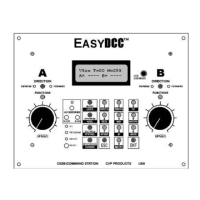124
Nuisance Issues That Have Easy Fixes
We receive many requests for help that fall into a category of nuisance issues. The only problem
was that the user needed some help to understand the cause and the solution. This page has some
of the more common questions arranged by observable symptoms.
Loco Runs Full Speed For A Few Seconds When Power First Applied
Decoders that offer “analog” operation (decoder can run with an ordinary power pack), may
accidentally switch over to analog mode while the Command Station is initializing. If this
occurs, program the decoder's CV29 to disable the analog mode. If this mode is desired, consider
keeping the locomotive on an unpowered section of track until the Command Station completes
the initialization sequence.
Another possible problem is an incorrect cable used between the Command Station and the
Booster or between multiple boosters. If you suspect this might be a problem, consider replacing
the cable with a new one.
Headlights Flash As Train Speed Changes and Other Odd Behavior
For each address used, the Command Station can be set to one of 3 speed step settings. Each
decoder can be set to either 14 or 28 speed steps (the 128 speed step setting is automatic and does
not require decoder programming). Obviously, the speed step settings must match. For example,
if the Command Station is set for 28 speed steps and the decoder is set for 14 steps, the
locomotive's headlight flashes as you change speed. Use the table below to help troubleshoot
speed step mismatch.
CS Decoder Result
14 28 Pushing F0 (headlights) changes locomotive speed
28 14 Headlamp flashes with speed change
128 14 F0 (headlights) will not work
128 28 OK but the decoder must support the 128 speed step mode
Locomotive Stops When Tethered Throttle Is Unplugged
Check for another throttle set to the same address. Don't forget to check the Command Station's
throttles too.
Some newer decoders may have a very short time set for the DCC packet time-out value, CV11.
Reset this value to provide a longer time.
A momentary interruption of the track signal (derailment, dirty track etc) can also halt a
locomotive running on memory. Memory is resident inside the decoder, not in the Command
Station. Consider cleaning the track and/or improving the locomotive's pickup if this becomes a
problem.
Locomotive Starts, then Stops, then Starts, Then Stops...
Some newer decoders may have a very short time set for the DCC packet time-out value, which is
CV11. Reset CV11 to a value of 0. This value disables the packet time-out.
Locomotive Doesn't Reach Top Speed Or Runs “Strangely”
If using XR1300 throttles, check for another throttle set to the same address. Don't forget to
check the Command Station's throttles too. This is where it pays to have recorded all of your
throttle ID numbers in the sheet following the Permanent Mounting section. To de-assign the
Command Station throttle, push SETUP , THROT-A (or B), ENT.
If using wireless throttles, check for duplicate ID numbers and/or duplicate frequencies. Each
wireless throttle must assigned a unqiue ID and a unique frequency.
If using both types of throttles, check both of them.
Train Doesn’t Run In One Section
If you were just working in the affected area, or an adjacent area, that is where to focus. Think
about what you were doing in that area and then check for broken unplugged power supplies,
feeder wires, broken bus wires or missing feeders.

